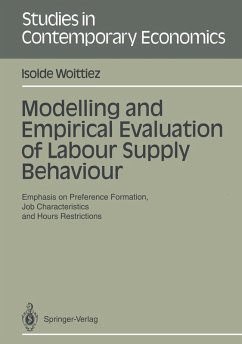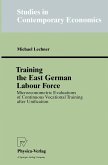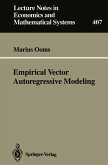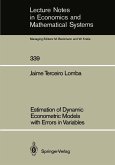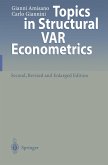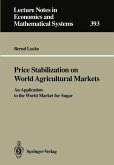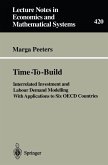Isolde Woittiez
Modelling and Empirical Evaluation of Labour Supply Behaviour (eBook, PDF)
Emphasis on Preference Formation, Job Characteristics and Hours Restrictions
72,95 €
72,95 €
inkl. MwSt.
Sofort per Download lieferbar

36 °P sammeln
72,95 €
Als Download kaufen

72,95 €
inkl. MwSt.
Sofort per Download lieferbar

36 °P sammeln
Jetzt verschenken
Alle Infos zum eBook verschenken
72,95 €
inkl. MwSt.
Sofort per Download lieferbar
Alle Infos zum eBook verschenken

36 °P sammeln
Isolde Woittiez
Modelling and Empirical Evaluation of Labour Supply Behaviour (eBook, PDF)
Emphasis on Preference Formation, Job Characteristics and Hours Restrictions
- Format: PDF
- Merkliste
- Auf die Merkliste
- Bewerten Bewerten
- Teilen
- Produkt teilen
- Produkterinnerung
- Produkterinnerung

Bitte loggen Sie sich zunächst in Ihr Kundenkonto ein oder registrieren Sie sich bei
bücher.de, um das eBook-Abo tolino select nutzen zu können.
Hier können Sie sich einloggen
Hier können Sie sich einloggen
Sie sind bereits eingeloggt. Klicken Sie auf 2. tolino select Abo, um fortzufahren.

Bitte loggen Sie sich zunächst in Ihr Kundenkonto ein oder registrieren Sie sich bei bücher.de, um das eBook-Abo tolino select nutzen zu können.
This book discusses new developments in the area of labour supply. Extensions of the neoclassical model are developed and estimated on Dutch data. Preference interdependence, habit formation, job characteristics and hours restrictions are the main issues.
- Geräte: PC
- ohne Kopierschutz
- eBook Hilfe
- Größe: 18.09MB
Andere Kunden interessierten sich auch für
![Training the East German Labour Force (eBook, PDF) Training the East German Labour Force (eBook, PDF)]() Michael LechnerTraining the East German Labour Force (eBook, PDF)40,95 €
Michael LechnerTraining the East German Labour Force (eBook, PDF)40,95 €![Empirical Vector Autoregressive Modeling (eBook, PDF) Empirical Vector Autoregressive Modeling (eBook, PDF)]() Marius OomsEmpirical Vector Autoregressive Modeling (eBook, PDF)72,95 €
Marius OomsEmpirical Vector Autoregressive Modeling (eBook, PDF)72,95 €![Estimation of Dynamic Econometric Models with Errors in Variables (eBook, PDF) Estimation of Dynamic Econometric Models with Errors in Variables (eBook, PDF)]() Jaime Terceiro LombaEstimation of Dynamic Econometric Models with Errors in Variables (eBook, PDF)40,95 €
Jaime Terceiro LombaEstimation of Dynamic Econometric Models with Errors in Variables (eBook, PDF)40,95 €![Econometric Analysis of Discrete Choice (eBook, PDF) Econometric Analysis of Discrete Choice (eBook, PDF)]() Axel Börsch-SupanEconometric Analysis of Discrete Choice (eBook, PDF)40,95 €
Axel Börsch-SupanEconometric Analysis of Discrete Choice (eBook, PDF)40,95 €![Topics in Structural VAR Econometrics (eBook, PDF) Topics in Structural VAR Econometrics (eBook, PDF)]() Gianni AmisanoTopics in Structural VAR Econometrics (eBook, PDF)72,95 €
Gianni AmisanoTopics in Structural VAR Econometrics (eBook, PDF)72,95 €![Price Stabilization on World Agricultural Markets (eBook, PDF) Price Stabilization on World Agricultural Markets (eBook, PDF)]() Bernd LuckePrice Stabilization on World Agricultural Markets (eBook, PDF)40,95 €
Bernd LuckePrice Stabilization on World Agricultural Markets (eBook, PDF)40,95 €![Time-To-Build (eBook, PDF) Time-To-Build (eBook, PDF)]() Marga PeetersTime-To-Build (eBook, PDF)40,95 €
Marga PeetersTime-To-Build (eBook, PDF)40,95 €-
-
-
This book discusses new developments in the area of labour supply. Extensions of the neoclassical model are developed and estimated on Dutch data. Preference interdependence, habit formation, job characteristics and hours restrictions are the main issues.
Dieser Download kann aus rechtlichen Gründen nur mit Rechnungsadresse in A, B, BG, CY, CZ, D, DK, EW, E, FIN, F, GR, HR, H, IRL, I, LT, L, LR, M, NL, PL, P, R, S, SLO, SK ausgeliefert werden.
Produktdetails
- Produktdetails
- Verlag: Springer Berlin Heidelberg
- Seitenzahl: 232
- Erscheinungstermin: 6. Dezember 2012
- Englisch
- ISBN-13: 9783642845086
- Artikelnr.: 53087088
- Verlag: Springer Berlin Heidelberg
- Seitenzahl: 232
- Erscheinungstermin: 6. Dezember 2012
- Englisch
- ISBN-13: 9783642845086
- Artikelnr.: 53087088
- Herstellerkennzeichnung Die Herstellerinformationen sind derzeit nicht verfügbar.
1. Introduction.
2 A simple neoclassical model of labour supply.
2.1 Introduction.
2.2 The model specification for one
adult households.
2.3 The model specification for two
adult households.
2.4 Data.
2.5 Estimation results.
2.6 Concluding remarks.
2A Wage equations.
2B A reduced form estimation of single male labour supply.
2C Derivation of the standard errors of elasticities.
3 The social security and welfare system and institutional constraints.
3.1 Introduction.
3.2 A nonconvex budget set.
3.3 The use of preferred hours.
3.4 Estimation results.
3.5 Concluding remarks.
3A Likelihood contributions.
4 Preference interdependence and habit formation.
4.1 Introduction.
4.2 A labour supply model with preference formation.
4.3 Estimation results.
4.4 A factor analytic model of reference groups.
4.5 The labour supply model reestimated.
4.6 Conclusion.
4A Social group means.
4B Identification.
4C Stability.
4D Correlation matrices of indicators.
5 Job characteristics.
5.1 Introduction.
5.2 The model.
5.3 Empirical results.
5.4 Conclusion.
5A Derivation of the reduced form.
5B The likelihood function.
6 Hours restrictions.
6.1 Introduction.
6.2 The model.
6.3 Estimation results.
6.4 Conclusion.
6A The expression for ejk and the likelihood function.
7 Comparison of several models.
7.1 Introduction.
7.2 Two
sample tests.
7.3 ?2 diagnostic tests.
7.4 Concluding remarks.
7A Partitioning of the endogenous variable.
8 Conclusion.
References.
2 A simple neoclassical model of labour supply.
2.1 Introduction.
2.2 The model specification for one
adult households.
2.3 The model specification for two
adult households.
2.4 Data.
2.5 Estimation results.
2.6 Concluding remarks.
2A Wage equations.
2B A reduced form estimation of single male labour supply.
2C Derivation of the standard errors of elasticities.
3 The social security and welfare system and institutional constraints.
3.1 Introduction.
3.2 A nonconvex budget set.
3.3 The use of preferred hours.
3.4 Estimation results.
3.5 Concluding remarks.
3A Likelihood contributions.
4 Preference interdependence and habit formation.
4.1 Introduction.
4.2 A labour supply model with preference formation.
4.3 Estimation results.
4.4 A factor analytic model of reference groups.
4.5 The labour supply model reestimated.
4.6 Conclusion.
4A Social group means.
4B Identification.
4C Stability.
4D Correlation matrices of indicators.
5 Job characteristics.
5.1 Introduction.
5.2 The model.
5.3 Empirical results.
5.4 Conclusion.
5A Derivation of the reduced form.
5B The likelihood function.
6 Hours restrictions.
6.1 Introduction.
6.2 The model.
6.3 Estimation results.
6.4 Conclusion.
6A The expression for ejk and the likelihood function.
7 Comparison of several models.
7.1 Introduction.
7.2 Two
sample tests.
7.3 ?2 diagnostic tests.
7.4 Concluding remarks.
7A Partitioning of the endogenous variable.
8 Conclusion.
References.
1. Introduction.
2 A simple neoclassical model of labour supply.
2.1 Introduction.
2.2 The model specification for one
adult households.
2.3 The model specification for two
adult households.
2.4 Data.
2.5 Estimation results.
2.6 Concluding remarks.
2A Wage equations.
2B A reduced form estimation of single male labour supply.
2C Derivation of the standard errors of elasticities.
3 The social security and welfare system and institutional constraints.
3.1 Introduction.
3.2 A nonconvex budget set.
3.3 The use of preferred hours.
3.4 Estimation results.
3.5 Concluding remarks.
3A Likelihood contributions.
4 Preference interdependence and habit formation.
4.1 Introduction.
4.2 A labour supply model with preference formation.
4.3 Estimation results.
4.4 A factor analytic model of reference groups.
4.5 The labour supply model reestimated.
4.6 Conclusion.
4A Social group means.
4B Identification.
4C Stability.
4D Correlation matrices of indicators.
5 Job characteristics.
5.1 Introduction.
5.2 The model.
5.3 Empirical results.
5.4 Conclusion.
5A Derivation of the reduced form.
5B The likelihood function.
6 Hours restrictions.
6.1 Introduction.
6.2 The model.
6.3 Estimation results.
6.4 Conclusion.
6A The expression for ejk and the likelihood function.
7 Comparison of several models.
7.1 Introduction.
7.2 Two
sample tests.
7.3 ?2 diagnostic tests.
7.4 Concluding remarks.
7A Partitioning of the endogenous variable.
8 Conclusion.
References.
2 A simple neoclassical model of labour supply.
2.1 Introduction.
2.2 The model specification for one
adult households.
2.3 The model specification for two
adult households.
2.4 Data.
2.5 Estimation results.
2.6 Concluding remarks.
2A Wage equations.
2B A reduced form estimation of single male labour supply.
2C Derivation of the standard errors of elasticities.
3 The social security and welfare system and institutional constraints.
3.1 Introduction.
3.2 A nonconvex budget set.
3.3 The use of preferred hours.
3.4 Estimation results.
3.5 Concluding remarks.
3A Likelihood contributions.
4 Preference interdependence and habit formation.
4.1 Introduction.
4.2 A labour supply model with preference formation.
4.3 Estimation results.
4.4 A factor analytic model of reference groups.
4.5 The labour supply model reestimated.
4.6 Conclusion.
4A Social group means.
4B Identification.
4C Stability.
4D Correlation matrices of indicators.
5 Job characteristics.
5.1 Introduction.
5.2 The model.
5.3 Empirical results.
5.4 Conclusion.
5A Derivation of the reduced form.
5B The likelihood function.
6 Hours restrictions.
6.1 Introduction.
6.2 The model.
6.3 Estimation results.
6.4 Conclusion.
6A The expression for ejk and the likelihood function.
7 Comparison of several models.
7.1 Introduction.
7.2 Two
sample tests.
7.3 ?2 diagnostic tests.
7.4 Concluding remarks.
7A Partitioning of the endogenous variable.
8 Conclusion.
References.
